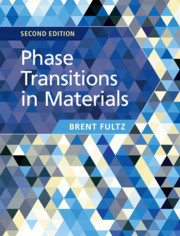Book contents
- Frontmatter
- Contents
- Preface
- Notation
- Part I Basic Thermodynamics and Kinetics of Phase Transformations
- Part II The Atomic Origins of Thermodynamics and Kinetics
- 6 Energy
- 7 Entropy
- 8 Pressure
- 9 Interactions in Microstructures and Constrained Equilibrium
- 10 Atom Movements with the Vacancy Mechanism
- Part III Types of Phase Transformations
- Further Reading
- References
- Index
7 - Entropy
from Part II - The Atomic Origins of Thermodynamics and Kinetics
Published online by Cambridge University Press: 24 April 2020
- Frontmatter
- Contents
- Preface
- Notation
- Part I Basic Thermodynamics and Kinetics of Phase Transformations
- Part II The Atomic Origins of Thermodynamics and Kinetics
- 6 Energy
- 7 Entropy
- 8 Pressure
- 9 Interactions in Microstructures and Constrained Equilibrium
- 10 Atom Movements with the Vacancy Mechanism
- Part III Types of Phase Transformations
- Further Reading
- References
- Index
Summary
The physical origins of entropy are explained. Configurational entropy in the point approximation was used previously, but Chapter 7 shows how configurational entropy can be calculated more accurately with cluster expansion methods, and the pair approximation is developed in some detail. Atom vibrations are usually the largest source of entropy in materials, and the origin of vibrational entropy is explained in Section 7.4. Vibrational entropy is used in new calculations of the critical temperatures of ordering and unmixing, which were done in Chapter 2 with configurational entropy alone. For metals there is a heat capacity and entropy from thermal excitations of electrons near the Fermi surface, and this increases with temperature. At high temperatures, electron excitations can alter the vibrational modes, and there is some discussion about how the different types of entropy interact.
Keywords
- Type
- Chapter
- Information
- Phase Transitions in Materials , pp. 171 - 203Publisher: Cambridge University PressPrint publication year: 2020

